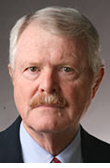Emeritus LAND prof’s book offers new approach to landscape design

Michael Murphy
In his new book, “ [Landscape Architecture Theory: An Ecological Approach] (https://islandpress.org/books/landscape-architecture-theory) ,” Michael Murphy, Texas A&M professor emeritus of landscape architecture, focuses on fostering health and vitality for humans and nature through design.
[ ] (https://islandpress.org/books/landscape-architecture-theory) Drawing on his extensive career in practice and teaching that began in 1969, Murphy, who retired from the Texas A&M faculty in 2011, explains how a strong understanding of landscape architecture theory can be applied to practical, everyday decision making and design to create more holistic, sustainable, and creative landscapes.
“His book provides a valuable resource for scholars, students, and practitioners who seek understand how the discipline can help guide change to improve the human condition," said Frederick Steiner, dean of the University of Pennsylvania School of Design.
One of Murphy’s former students, Chris Mulder, an [outstanding alumnus] (https://www.arch.tamu.edu/community/formerstudents/outstanding-alumni/past-honorees/55/) of the College of Architecture and principal of [CMAI] (https://www.cmai.co.za/) , a design and planning firm in South Africa, said that Murphy’s models of multidisciplinary planning and design collaboration are particularly important in technically and environmentally challenging large-scale development projects.
Murphy’s book includes an examination of landscape architecture’s influences, such as social context and contemporary values.
He also covers systems and procedural theory, and links the ecosystem, human factors and aesthetics, to the design process.
In 2005, Murphy authored “ [Landscape Architecture Theory: An Evolving Body of Thought] (https://www.amazon.com/Landscape-Architecture-Theory-Evolving-Thought/dp/1577663578) ,” a book cited as an important addition to the small body of literature that synthesizes the broad and varied theories upon which landscape architecture depends.
After earning a Master of Architecture degree from the University of California-Berkeley in 1968, Murphy joined the Texas A&M faculty, where he taught interdisciplinary design and programming, environmental planning and design and landscape architecture theory.
He also directed numerous projects in the [Department of Landscape Architecture and Urban Planning] (http://laup.arch.tamu.edu/) ’s Partnership for Community Outreach program, in which students created designs and plans for Texas communities.
Murphy earned two bachelor’s degrees from Texas A&M: a [Bachelor of Landscape Architecture] (http://laup.arch.tamu.edu/academics/undergraduate/bla/) degree in 1966 and a Bachelor of Science in Range Science degree in 1961. In 1999, he earned a Ph.D. from the University of Pretoria.
He was named an [Outstanding Alumnus] (http://www.arch.tamu.edu/community/formerstudents/outstanding-alumni/past-honorees/134/) of the Texas A&M College of Architecture in 2012, one of his many awards and honors.
Tags
- academics
- feature
- landscape architecture & urban planning
- research
- rss
- sustainability
- theory-philosophy
Related Posts

College hosts international LAUP conference

Green roof growing atop Langford A

Summit explored education advances with ‘smart’ cities

New CHUD director shares vision for center's expansion
Follow Us
Facebook Twitter Vimeo Youtube Flickr RSS
Recent Posts

Planning prof heads study of disaster housing aid

A message from the dean

Former student remembered as expert planner

Leading educator named new head of Architecture Dept.





_thumbnail_small.png)
